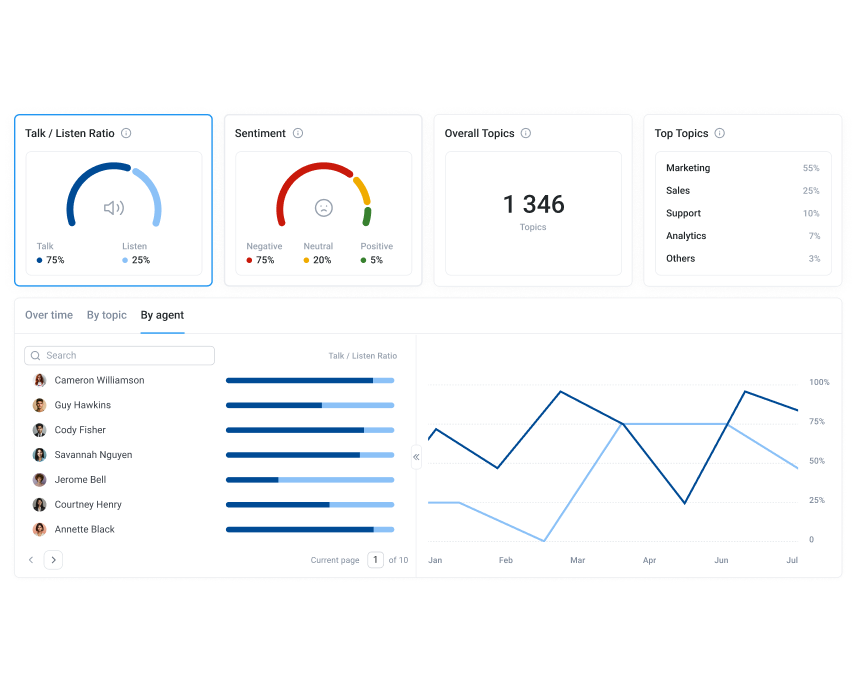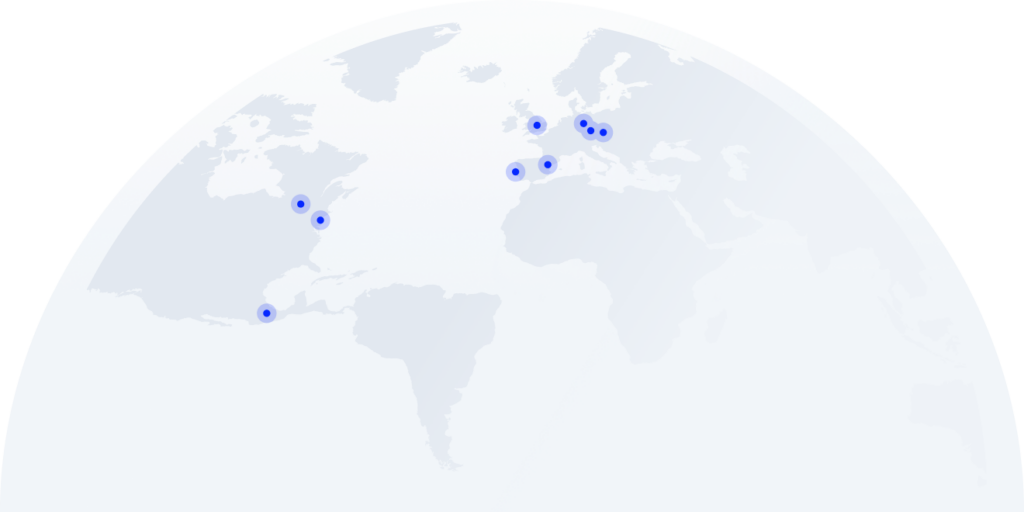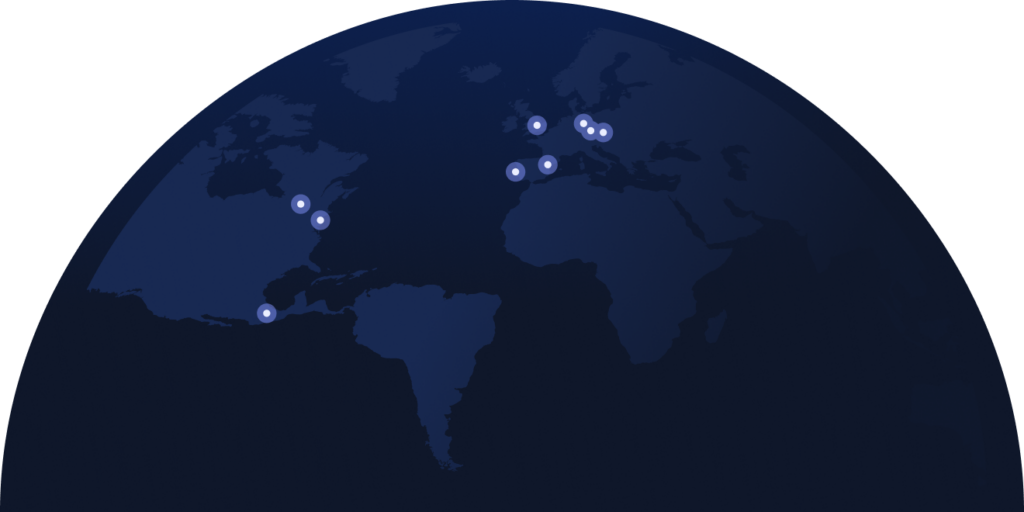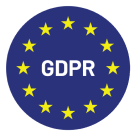CSAT Score Explained: Meaning, Practical Use Cases, and Advanced Insights

88% of companies today rely on CSAT scores to track success and customer satisfaction.* Yet, satisfaction levels have hit an all-time low in the U.S.—dropping from an average of 72.0 in 2021 to just 69.3 in 2024.* The problem? CSAT scores alone don’t give the full picture.
You might be a sales leader looking to drive revenue through higher engagement or a customer service manager aiming to minimize unhappy customers. Either way, you need more than just numbers—you need insights that tell you why customers feel the way they do.
Let’s say a customer rates their support experience as a 3 out of 5. That score alone doesn’t tell you whether the issue was long wait times, an unhelpful response, or something completely unrelated. Without deeper analysis, you’re making blind guesses about how to improve.
In this guide, we’ll explain how to properly leverage CSAT scores to improve the customer journey. We’ll also look at how modern tools can transform the data from these surveys into clear, actionable insights.
Key Takeaways:
- Tracking CSAT helps businesses across multiple sectors understand satisfaction at critical touchpoints in the customer journey.
- Turning the raw data from CSAT surveys into actionable insights requires the use of advanced tools like machine learning and predictive analytics.
- Modern tools from CloudTalk like Sentiment Analysis, Call Monitoring, and Interactive Voice Response can significantly enhance the usability of CSAT data.
Uncover new customer insights with AI-powered features.
What is a CSAT score?
CSAT, or Customer Satisfaction Score, is a metric used to quantify how happy a customer is about a specific interaction, product, or service.
This differs from other key metrics like Net Promoter Score (NPS) and Customer Effort Score (CES) in both scope and intent. Where NPS is used to assess long-term customer loyalty and CES focuses on ease of interaction, CSAT is used to assess satisfaction immediately after engaging with your company.
A customer satisfaction survey normally involves asking customers to rate their satisfaction on a numerical scale, i.e. 1 to 5, with 5 representing the highest satisfaction.
The total CSAT score is then produced by dividing the number of satisfied responses (I.e. ratings of 4 or 5) by the total number of responses and multiplying by 100. This produces a percentage representing the CSAT score, for example, if 160 out of 200 respondents were satisfied, the CSAT score would be 80%.
These CSAT surveys are often conducted right after a key customer interaction, such as post-purchase or post-customer service call. This makes sure feedback is relevant and helps illustrate how the customer is feeling immediately after interacting with the business.
Modern tools allow for further analysis of customer satisfaction as companies can cross-reference basic percentage scores with other metrics to provide a holistic view of the customer experience.
Why is CSAT Important?
CSAT provides an objective way for you to assess how well your efforts to improve the customer experience and build customer loyalty are working.
Meanwhile, analyzing the data from these surveys allows you to quickly pinpoint improvement areas. For instance, say your support team has a CSAT of 90%—but your churn rate is climbing. A deeper dive into qualitative feedback might reveal that customers appreciate friendly service but are frustrated by long wait times. Without that context, your next steps could be completely misaligned with what customers actually need.
This lets you investigate the cause and take the right remedial action, be it new training packages, a more advanced calling solution, or better call routing to more qualified agents.
This continuous feedback loop leads to higher CSAT scores which frequently correlate with increased customer retention, positive word-of-mouth referrals, and higher customer lifetime value (CLV).
CSAT data can also be leveraged to drive growth and inform decisions at a strategic level. You might tailor product and service offerings or outreach strategies based on customer feedback, for example.
How to Measure CSAT Effectively
Properly harnessing the feedback available though CSAT surveys is about more than asking the right questions. You’ll also need to consider the right time to ask and how they’re framed to maximize response rates and generate actionable insights. Let’s take a closer look.
Design the Right Questions for Your Survey
The effectiveness of a CSAT survey hinges on how well you frame the questions within it. The goal here is to gain the clearest, most actionable feedback in as brief a survey as possible. This means you’ll need to delicately balance the need for information with the effect on response rates that longer surveys have.
If you’ve ever received a long survey after a customer interaction, you know how frustrating it can be. The longer and more complex the survey, the more likely customers are to abandon it altogether.
Questions should be direct, and focus on a specific interaction or service. The most common format for these questions is something along the lines of:
“How satisfied were you with [specific interaction]?”
This can then be varied based on the nature of the survey, offering a more granular level of detail through variations like:
- “How would you rate your satisfaction with our customer support today?”
- “How satisfied are you with the ease of use of our platform?”
- “How happy are you with the resolution provided by our team?”
Try to avoid vague or overly complex wording, and ensure that the survey doesn’t ask leading questions such as “How much did you enjoy our excellent service?” as this can skew results by assuming the customer experience.
It’s also a good idea to add an optional open-ended question after the basic satisfaction score. Some customers may have more detailed thoughts which are vital in uncovering the why behind their numerical rating.
However, it’s important this doesn’t replace the numerical score, as including only open ended questions can alienate time-stretched customers who want to rate quickly and move on with their day.
Choose the Appropriate Scale
CSAT surveys usually use a numerical scale for customers to rate their experience. However, different numerical ranges can impact data collection and interpretation so it’s important to use the one most suited to your application. The most common scales are:
- 1 to 5 scale: Commonly used to assess general satisfaction, where 1 means “very dissatisfied” and 5 represents “very satisfied.” This scale is simple and intuitive, encouraging quick answers from respondents.
- 1 to 7 scale: A more granular scale used for deeper questions which provide a wider range of response options.
- Percentage-based (0–100%): More common in industries like SaaS, it offers greater precision but requires more thinking from respondents. The greater range allows for deeper comparative analysis due to more data points.
- Emoji or star ratings. You’ll see these in mobile apps or quick in-chat feedback requests. While simple, the responses can lack the nuance needed for more in-depth analysis.
The scale you choose will depend on the context and your target audience. A 1-5 scale is ideal for broader customer bases due to its simplicity and speed to answer. Meanwhile, a 1-7 scale or a percentage-based system may be more suitable for detailed feedback that supports more precise customer sentiment tracking.
It’s important to set this up right the first time around, as changing rating scales can make it difficult to benchmark current efforts against historical data. For example, a 7/10 doesn’t divide to represent any numbers on a scale of 1-5, cumulatively skewing data.
Select the Best Timing for Surveys
Timing plays a key role in obtaining useful data pools of CSAT responses. The sooner a survey is completed after an interaction the more likely a customer is to provide accurate and reflective feedback. Different touch-points and delivery methods are likely to require different strategies here, for example:
- Post-purchase surveys: Sent immediately after a successful transaction so that the purchasing experience is fresh in a customer’s mind. For example, e-commerce platforms can ask customers to rate their shopping experience after making an order.
- Customer support iInteractions: These should be sent immediately after the support case is closed. If the CSAT survey is sent too late, customers might forget details or how they actually felt during and immediately after the interaction.
- Onboarding and product usage: For SaaS teams, CSAT surveys can be embedded directly into user interfaces. Feedback can then be prompted after certain actions, like starting an account or using a certain feature.
- Periodic satisfaction checks: Businesses sometimes send periodic CSAT surveys throughout the year for long-term partnerships or customer journeys. This also allows for clear comparative analysis over time.
Whichever approach you take, it’s usually best to introduce a CSAT survey to the customer as soon as possible. Due to the increasing role CSAT plays across multiple sectors, many customers experience what’s called ‘survey fatigue’. This means leaving surveys sitting in email inboxes or sending them days later which often leads to low response rates and disengagement.
Choose Your Delivery Method for CSAT Surveys
The effectiveness of a CSAT survey also depends on how it’s delivered to the customer. You’ll need to align your distribution method with customer preferences on communication channels to ensure quality feedback and useful response rates. Common methods include:
- Email surveys: Allow for personalized messaging and are an easy way to integrate optional follow-up questions. However, they need to be brief and include carefully crafted subject lines to garner strong open rates and encourage completion.
- In-app or website surveys: Used by SaaS companies and e-commerce platforms, embedding the CSAT survey directly into the app or website. Customers might be asked to give feedback based on specific triggers, such as using a certain feature or making a purchase.
- SMS surveys: Text-based surveys offer quick feedback requests and generally garner high open rates. However, they need to be concise due to character limits on texts.
- Live Chat or Support Portal Surveys: Businesses offering omnichannel customer service will often integrate CSAT surveys directly into the support chat windows. This allows for immediate feedback but isn’t always ideal for more detailed responses.
There’s also Interactive Voice Response (IVR) Phone Surveys. These are common in call centers and offer a rapid way to collect CSAT ratings at the end of a call. Interactive Voice Response means the questions are automatically asked and can be quickly set up or altered.
This means agents don’t need to manually ask for feedback each time while automating the collection of CSAT data, boosting efficiency without sacrificing key insights. IVR also cuts down wait times and routes calls to the best agent based on skills or location, allowing for better first-call resolution rates and higher CSAT scores in the first place.
No matter the delivery method you use, it’s important to align it with how your customer wants to interact with your brand…
Let’s take customer support for example. Salesforce reports show that 61% of customers prefer to talk over the phone. This means an IVR-powered CSAT survey that flows naturally following a voice call is likely to yield better results than an email 5 minutes later.

Advanced Techniques for Analyzing CSAT Data
Accurately measuring CSAT is the tip of the iceberg when it comes to leveraging data to improve the customer experience. You can extract deeper insights using analytics and other advanced tools to turn raw insights into actionable strategies.
In this section, we look at how you can move beyond raw scores to uncover trends, predict future satisfaction, and continuously refine the customer experience.
Leverage Sentiment Analysis to Uncover Hidden Insights
How a customer feels and how a customer tells you they feel don’t always perfectly align. While surveys can provide quantitative scores, the real value of CSAT is often the more nuanced feedback a customer provides through open-ended questions.
Sentiment Analysis takes this a step further, allowing you to analyze the language, tone, and emotional context behind the raw numbers to understand customer satisfaction on a new level.
Sentiment Analysis uses natural language processing (NLP) to detect the subtle dissatisfaction often missed during basic numerical surveys. It can also measure the emotional intensity of this dissatisfaction in a customer’s speech pattern.
AI-driven analysis of these sentiments then allows customer interactions to be categorized into groups, along with actionable insights on what caused the shift in sentiment. You can leverage this in real-time through an interactive Real-Time Dashboard or use it to give context and verify the accuracy of CSAT survey scores.
Sentiment analysis tools like CloudTalk also include supporting tools to boost the level of insight gained from sentiment analysis. For example, automatic Call Transcription records and transcribes all calls. You can then use Analytics to cross-reference topics with negative sentiment to understand which conversation triggers caused the negative sentiment shift.
This unlocks a data-driven approach to refining a customer service or sales strategy by revealing exactly what’s working and what isn’t. Managers can then intervene in either real-time or through remedial actions like training packages.
Integrating AI-powered features like sentiment analysis into CSAT measurement leads to reduced churn, allowing for rapid strategic change based on how customers really feel.

Use Machine Learning for Trend Prediction and Segmentation
Machine learning algorithms can analyze large datasets of CSAT scores to detect patterns and predict trends in customer satisfaction.
Whereas businesses would traditionally use manual methods to evaluate CSAT survey results, modern AI-powered models can remove busywork and cross-reference results with wider factors such as:
- The type of product or service purchased
- The time of day or support channel used
- Customer demographics or previous interactions
The trends revealed by CSAT scores combined with data from sentiment analysis can then be used to segment customers into groups based on satisfaction. This allows you to tailor your follow-up strategy and give each customer relationship exactly what it needs. For example you can target:
- Highly satisfied customers for loyalty programs or referral schemes.
- Neutral customers with more personalized engagement to improve the CX.
- Highly dissatisfied customers for proactive support, rewards, or incentives.
Machine learning models can also be used to predict the influence of outside factors on CSAT scores, such as seasonal fluctuations. For example, a customer service provider might note a drop in satisfaction due to longer waiting times resulting from delivery delays around the holidays. By analyzing the historical data, ML can reveal the changes needed (such as higher staffing) around these times to maintain satisfaction.
Utilize Predictive Analytics for Proactive Decision-Making
Predictive analytics build on the work done by machine learning, using real-time and historical data from wider sources to forecast future customer behaviors. This lets you take proactive action and identify at-risk customers before they even have a bad experience.
This is vital in predicting churn and optimizing the customer journey, allowing you to optimize resource allocation based on data as opposed to guesswork. Because of this, many industries are already using this combination of CSAT and modern data analytics.
For example, SaaS companies can detect warning signs of churn by cross-referencing declining CSAT scores with reduced engagement with individual features. Retail industries on the other hand can cross-reference CSAT scores with purchase history to help forecast future sales.
Integrating customer experience metrics with wider data in this way represents a shift from reactive problem-solving to proactive customer engagement. This strengthens long-term relationships and saves those that are at risk.
Pro tip:
Learn more about CloudTalks VoIP solution with advanced features like Call Monitoring and Interactive Voice Response (IVR)
Industry-Specific Applications of CSAT
While CSAT measurement is universally valuable to any customer-facing business, different industries have implemented it in unique ways to tackle their unique challenges. Here’s a closer look.
CSAT in Financial Services
Customer satisfaction can be more complex for banks, insurance providers, or fintech companies, especially when there are high stakes decisions at play like mortgage approvals or claims processing.
Common customer satisfaction metrics across this sector cover areas like loan approvals & applications, claims & dispute resolution, and customer support interactions.
Many of these are highly sensitive to the disproportionate negative feedback induced when customers receive denials or claims are rejected. This makes it extremely difficult to accurately gauge satisfaction with the actual service being provided.
This is a key area where sentiment analysis can help. By separating out the customer who had a bad experience on the phone and customers who were simply dissatisfied with the outcome, sentiment analysis allows financial services businesses to accurately segment their customers and define strategy.
CSAT in SaaS
Unlike more transactional businesses, SaaS relies on the ongoing engagement of users, making predicting retention and churn absolutely essential for business planning.
CSAT represents a key metric for tracking this engagement at critical points in the user journey. Onboarding is a common touchpoint here, letting customers rate their experience. You’ll also see CSAT used to measure feature adoption, allowing customers to rate the intuitivity of UI/UX.
CSAT surveys can also be used to gauge reactions to product updates or new feature launches, further enhancing the continuous improvement approach that defines the success of subscription-based software.
CSAT in E-commerce and Retail
E-commerce and retail stores often rely on CSAT to measure satisfaction across the wider shopping experience. This includes CSAT data points relating to every step, from product discovery to post-purchase support.
For e-commerce specifically, key measurements can also include factors like ease of website navigation, checkout simplicity, and delivery.
Factors like slow delivery times, mismatched customer expectations of products, or a lack of after sales follow-up can all contribute to poor CSAT scores; measuring satisfaction in these areas allows you to pinpoint which area of the customer journey is lacking.
Higher CSAT Scores Boost Stock Prices*
Let’s say your SaaS company rolls out a new feature, and your CSAT scores remain steady at 82%. On the surface, everything looks fine—no major drops in satisfaction. But when you dig into qualitative feedback, you uncover a recurring theme: Customers are confused about how to use the feature, and support tickets have doubled.
The issue? Customers aren’t unhappy with the feature itself—they’re frustrated because they don’t understand how to use it properly. The CSAT score alone didn’t capture this struggle, and without deeper analysis, your company might assume adoption is going smoothly when, in reality, it’s creating friction.
This is why leading companies treat CSAT as a starting point, not the finish line. By delivering the right questions at the right time in the right way, you can accurately gauge how your customers truly experience your brand.
Plus, modern tools like CloudTalk’s Sentiment Analysis give context to raw CSAT data and offer an unrivaled ability to refine CX strategies and build customer success.
Uncover new insights with AI-powered features
*Sources
- Salesforce, State of Service, 2024
- Forrester, CX in the U.S. Falls to an All-Time Low. 2024
- SurveySparrow, Customer Satisfaction Statistics, 2024
FAQs about CSAT Scores
What’s a CSAT scoring guide?
A CSAT scoring guide explains how to measure, interpret, and improve customer satisfaction ratings based on survey responses.
What does the CSAT rating mean?
CSAT ratings reflect the customer experience with a product, service, or interaction, usually measured on a scale from 1–5 or 1–7.
What does a CSAT score mean in a call center?
In a contact center, CSAT measures how satisfied customers are with agent interactions, response times, and issue resolution.
How do you calculate a CSAT score out of 5?
To calculate CSAT, divide the number of satisfied responses (4–5 ratings) by the total responses, then multiply by 100 to get a percentage.
Where can I find a CSAT score calculator?
You can find free CSAT score calculators online.
























